
WARNING: HARDSTYLE BREATHING AND MUSCLE TENSION TECHNIQUES FEATURED IN THIS BOOK ARE NOT APPROPRIATE FOR PEOPLE WITH HEART PROBLEMS, HIGH BLOOD PRESSURE, AND SOME OTHER CONDITIONS. CONSULT A PHYSICIAN BEFORE UNDERTAKING THESE TECHNIQUES AND EXERCISES.

TO SEARCH FOR THE OLD IS TO UNDERSTAND THE NEW.
—GICHIN FUNAKOSHI
The first thing you are going to learn is how to breathe in a manner that compresses your viscera hard enough to make a diamond—Hardstyle breathe. Exercises of this type supposedly date 1,500 years back to Bodhidharma, semi-mythical progenitor of Asian martial arts. More importantly, they have been endorsed by top Russian scientists.8
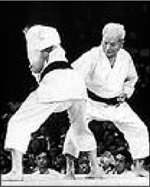
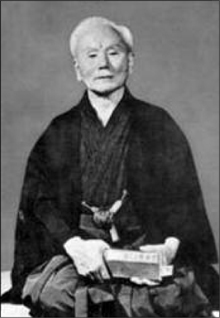
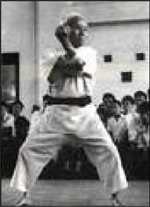
Gichin Funakoshi, founder of modern karate-do.
Testing the effectiveness of Hardstyle breathing. Don’t try it at home. According to Don Ross, if you goof up and let the air pressure—up to 600 pounds according to the late Mr. America and performing strongman—back up into your lungs you could die from lung barotrauma. It reminds me of AVM-1, an old Soviet scuba rig… but I have digressed.
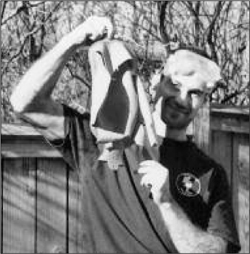
There are at least four reasons to Hardstyle breathe:
1. For strength
2. For stronger activation of all midsection muscles
3. For back health
4. For a tighter waist
First, for strength.
You will rarely if ever come across this reflex in Western literature: the pneumo-muscular reflex.9 It can be compared to the amplifier of your stereo, where your brain is the record player and your muscles are the speakers. Special baroreceptors in your abdominal and thoracic cavities register the internal pressure and adjust your muscular tension like the volume control knob. The higher is this pressure, the greater your strength—and vice versa.
Martial artists have possessed the knowledge of this powerful reflex for centuries. A blood curdling “K-i-a-i!” does more than intimidate the opponent and raise the fighter’s spirit. A sudden compression of the air by a powerful contraction of torso muscles peaks the intra-abdominal pressure (IAP) at the moment of the impact. This dramatically increases the power.
Second, for a stronger activation of all midsection muscles. The pneumo-muscular reflex alone will make your abs and obliques fire harder when you have squeezed your viscera with Hardstyle breathing. Another “muscle software app”, irradiation, will make them tense even harder. When a muscle contracts intensely, its excitation spills over to its neighbors and gets them all worked up as well. “In union there is strength.” So the fact that the muscles responsible for building up the IAP like the transversus and the internal obliques are working hard will make the abs, the external obliques, etc. work harder too.
Third, for back health.
The contraction of many muscles of the midsection stimulated by Hardstyle breathing strengthens these muscles and builds a strong brace for your back. And the fact that you are learning how to maximize the intra-abdominal pressure adds another protective mechanism, pneumatic-hydraulic. Just imagine how much more impervious your spine would be if instead of wiggly inner organs you had a blown up tire in your abdomen! No need to imagine any more.10
Fourth, for a tighter waist.
The resistance created by Hardstyle breathing not only trains the superficial muscles of the abdominal wall but also the “warriors of the invisible front” like the transversus abdominis and the internal obliques.
You have heard a lot about the role of the TVA in back health and a tight looking waist. While this muscle does play a role in both, the common cues for activating it, to “suck your stomach in” or “pull the belly button towards the spine, are dangerous and ineffective.
Try this experiment. Stand up. Blow out all of your air, then, without taking any in, force your ribcage open. Your stomach has miraculously pulled in. What happened?—Opening the chest without inhaling makes the little air left in your lungs take up more space. That means low gas pressure. Nature abhors vacuum or anything close to it, so if air is unavailable, something else will rush in to fill the space. Your gut will do just that. The belly button is in. Without any help from the TVA.
Since high intra-abdominal pressure is essential for spine stability under load, “hollowing” is obviously a losing strategy for your squats and deadlifts. From the purely architectural point of view it does not make any sense either: a concave wall will collapse long before a straight one. I know lifters who fell for the hollowing fad in the nineties and they had nothing but injuries to show for it. Don’t repeat their mistakes.
Even if lifting heavy things is not on your menu and looking good is all that matters—you big sissy!—you still want to up your IAP in your ab training because this happens to be one of the key functions of the TVA. Like a boa, it constricts your gut’s contents.
But enough theory; let us get down to business.
Stand up with your knees slightly bent. Poke your fingers into your abs and obliques doing your best not to shrug your shoulders. Palpating your muscles will allow you to gauge their tension and thus tense them even more.
Take a diaphragmatic inhalation of approximately ½ to ¾ of the max volume. Pull air “…not [into] the upper stomach,” stressed the late karate great Mas Oyama, “…force it into the groin. Force the air down, down… [and] force your feet… right through the ground.”
If you have forgotten how to belly breathe as all kids do, practice the “crocodile breath” from the arsenal of Gray Cook, RKC and Brett Jones, Master RKC. The latter explains:
Begin lying face down with your forehead on your hands, both palms down, one covering the other. Make sure the chest and arms are relaxed and you are as “flat” as you can get; your neck should be neutral and comfortable.
Breathe in through the nose and feel the air move down past the chest into the “stomach”. When this happens, you will feel the abdomen push out against the ground. This should happen naturally without you forcing your stomach out.
Exhale fully before beginning the next breath cycle.
The key points:
• Avoid breathing into the chest first and raising the shoulders.
• Inhale and exhale through the nose at a natural pace taking 80% or larger inhalations and long exhalations.
• You may exhale through the mouth.
• Don’t rush; there is a natural pause between the inhalation and exhalation cycles.
• The floor will provide automatic proprioceptive feedback as the abdomen pushes out against it. It should also guide you to breathe into the obliques and into the back.
• Perform 20-30 breaths in the beginning of a training session but shoot for 3-5 minutes of breath work at some later point.

Master RKC Brett Jones demonstrating the “crocodile breath”. Photo courtesy Brett Jones
Pull up your sphincters as if you are trying to restrain yourself from making both kinds of nature’s calls. This maneuver, practiced for millennia in many martial arts, serves several purposes. To understand them you need to know a smidgen of anatomy.
Think of the area from your sternum down to the bottom of your pelvis as a box. The rectus abdominis (RA) or the “six-pack” is the front of the box, various back muscles are the back, the obliques are the sides. The top of the box is the diaphragm, a muscle that works like the plunger of a syringe. When it contracts and pushes down, it creates a lower pressure in the lungs, and you take an abdominal inhalation. The diaphragm also bears down to up your intra-abdominal pressure when you are lifting heavy weights. The bottom of the “box” is the pelvic diaphragm, which prevents the works from falling out and buys you time when you are looking for a bathroom.
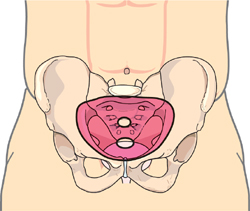
The Pelvic Floor

JDC has built his impressive abs with dynamic tension and Hardstyle breathing practices from Iron Shirt Qigong.
In our strength training practice we pull up the pelvic diaphragm and employ the “sphincter lock” for the duration of the strain. First, for health reasons. Although the pelvic floor muscles go live reflexively in response to an increased intra-abdominal pressure11, a little extra insurance will not hurt. The late karate master Gogen Yamaguchi reportedly got some heavy-duty hemorrhoids for failing to employ the sphincter lock during his dynamic tension kata practice. The powerlifting community has its own share of horror stories. In addition to preventing the obvious, strengthening the pelvic floor (PF) muscles has some other health benefits that are outside of the scope of this book.
My friend and publisher John Du Cane, who has spent decades studying Chinese martial arts, offers useful pelvic floor training recommendations:
Many Qigong and Tai Chi masters recommend holding the perineum (area between anus and genitals) up the whole time you are practicing. Many recommend that you pull up the perineum throughout the day. If you get in the habit of gently pulling it up area as often and as much as you can, you will gradually become much more accomplished at isolating this key area and technique, for strength and energy preservation/generation. When you are then pulling up the perineum area in a more concentrated manner for particularly intense exercises like the squat or Iron Shirt Qigong, you will have developed a better ability to maintain the lock.
Second, because the pelvic diaphragm is an extra “compressor” which allows us to get the IAP even higher. And third, to amplify the tension of the abdominals reflexively. A contraction of the PF muscles automatically “lights up” the abs, obliques, and TVA.12 Researchers poetically commented that “…contractions of the pelvic floor cast their shadow upon the abdominal muscles.”13
So you have taken a 50-75% abdominal inhalation and pulled up your sphincters. Now press your tongue behind your teeth and hiss, trying to contract the abdomen as intensely as possible. It is important to press hard with your tongue in order to leave only a very small opening for the escaping air. Think of your mouth as the nozzle of an air hose. When it is relaxed, air flows out freely and builds up no pressure. But when you press your tongue against your teeth, as if to make the sound “TSSSSSSS!!!”(try pronouncing my last name), it is as if you have plugged the end of the hose with your thumb. Suddenly very little gas can escape and the pressure inside the tube goes way up. There are many types of pressurized or Hardstyle breathing. In the author’s experience hissing is superior for forging a killer six-pack.14


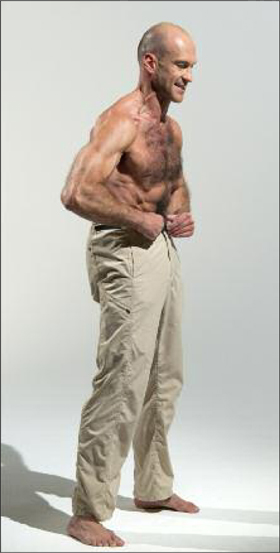
Side view of Hardstyle breathing.
Instead of one long hiss make a series of hisses, each mini-rep progressively ramping up more and more pressure. On a single inhalation. It will probably take 5-10 mini-hisses to empty your lungs but don’t bother counting. That was one set.
Over time optimize the number and duration of each mini-hiss to get the most powerful abdominal contraction.
Your spine will naturally flex somewhat as you are blasting your air out. Let flexion happen—but don’t make it happen. Full lumbar flexion is unnecessary for maximum abdominal recruitment15 and the focus on rounding your back takes away from the intensity of the contraction. Listen to Alwyn Cosgrove: “Try to find a crunching motion that creates the most intense pressure on your abdominal muscles with the least movement in your lower back. That’s the sweet spot of abdominal training.”
Rest for a few minutes before your next set to avoid getting light headed.
In all your Hardstyle drills keep the pressure below your sternum—not in your face, head, or neck. It is a skill. Don’t increase the intensity of contraction until you have figured it out.
Keep your shoulders down. Gray Cook has made an insightful observation that many people “use their neck and traps as the core”. Don’t be one of those.
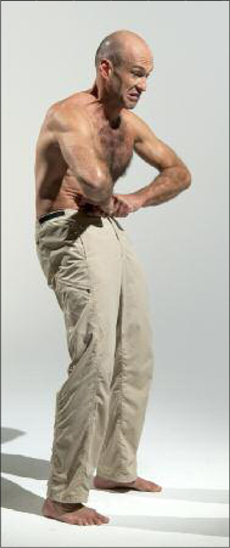
Too much spinal flexion and posterior pelvic tilt!

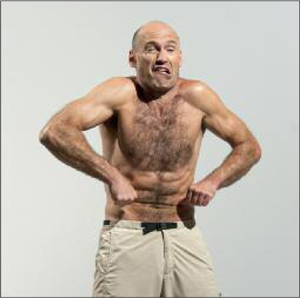
There are no such things as “Hardstyle face” and “Hardstyle traps”! Knock it off!
Don’t rush your Hardstyle breath as this would drop the pressure; it should take you a good five seconds or longer to empty your lungs. And don’t purse your lips as if you were in a Pilates class. “Hiss, don’t kiss”, chuckles Jon Engum, Master RKC and 7th Dan in Taekwondo.

“Hiss, don’t kiss!”
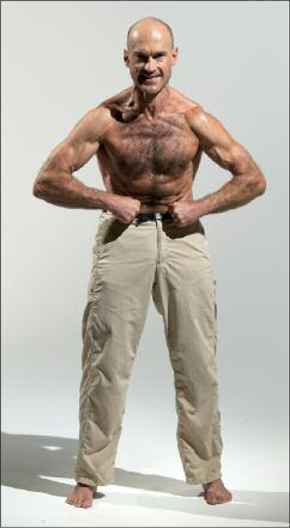
Front view of Hardstyle breathing
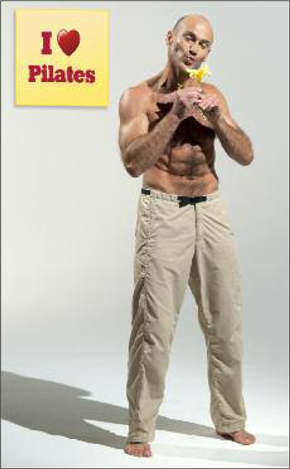

On the subject of the depth of your inhalation and exhalation. Victor Popenko, a Russian martial arts strength and conditioning expert, warns, “A person must never have too much or too little air in his lungs.” He explains that too much air prevents maximal tensing of the abdominal muscles. Indeed, Russian researchers showed that the greatest strength is achieved when the lungs contain 75% of their vital capacity.16 Not enough air is just as bad. “When you exhaust your complete breath, a weak spot occurs,” warned karate master Kanbun Uechi.
However, since your spine is not under load and hopefully no one is punching you, you may hiss out all of your air when practicing the above Hardstyle breathing drill. You should get a near cramp in your abbies if you do it right. Your waist will naturally shrink as you are squeezing the air out—but don’t purposefully pull your stomach in for a beauty queen’s fake TVA activation!
On your next set add another Hardstyle subtlety: clench your glutes as well—“pinch a coin”.
I cannot overstress how important it is to follow the instructions in this book to the letter! Such subtleties are the essence of the Hardstyle Abs program. A seemingly identical exercise performed with a different intention can have a radically different effect. For example, in one study the subjects increased the intensity of the external oblique (EO) contraction by approximately 35% and internal oblique (IO) by approximately 80% when the researchers added a set of specific cues to an abdominal exercise!17
The resting tension in your abs will increase very quickly. This is great, as long as you do not let the muscles get short. Start stretching and relaxing them between sets. Pick any one of the following exercises.
1. Lie on your back, your legs straight, your head resting on the deck. Gently and rhythmically chop your abs and obliques with the ridges of your hands.

Stretch your arms overhead, and make yourself as long as possible, roll and bend side to side for an extra stretch to your waist.

2. The prying cobra. Lie on your stomach with your feet a shoulder’s width apart or wider. Plant your hands on the ground, level with your solar plexus. Take a breath, lengthen your spine from head to toe, and push up until your elbows are straight and your shoulders are down. Squeeze your glutes (essential for back safety) and get a big chest. Shift your hips side to side and turn them in order to “pry” the top of the thighs (the hip flexors) and stretch the abs.
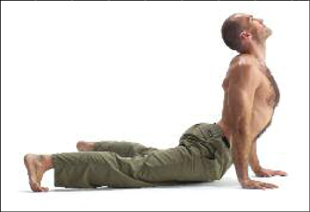
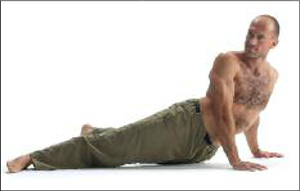
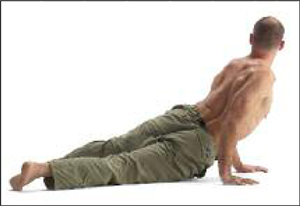

3. Lie on your back on a Swiss ball, your feet hooked under a couch so you can relax and not worry about rolling around. “Lengthen” your spine, stretch your arms, get a big chest, and tighten the glutes. Let your head hang loose. Shift your hips side to side and turn them in order to stretch your midsection and lengthen your spine even more. If necessary, hold on to something for balance. Breathe in a relaxed, passive manner—the opposite of Hardstyle breathing.
To get back up safely place your tongue on the roof of your mouth, squeeze your glutes, and crunch up before sitting up.
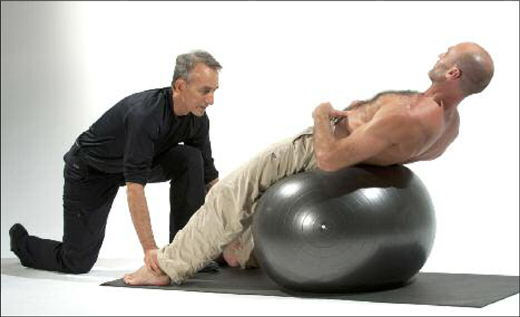
Let us put a finishing touch on the Hardstyle breathing exercise with an ancient technique I call the “karate navel maneuver”. The late karate master Masatoshi Nakayama advised: “For strength and stability, it is necessary to have the feeling that the line connecting the navel and the anus is short as possible.” It is really another cue to fire up your pelvic floor muscles even more. In addition to contracting the sphincters, the PF muscles tuck in your tailbone, which creates what Prof. Stuart McGill calls “superstiffness”.
Initially practice this technique with your knees straight in order not to cheat by performing a posterior pelvic tilt instead.18 As you are progressing through your Hardstyle breath, bring your tailbone and your navel close together while keeping your legs straight and your kneecaps pulled up. Tense your glutes hard—crush an imaginary walnut—at the same time. Later, once you have understood this subtle movement, you may unlock your knees and add a moderate posterior pelvic tilt to it.


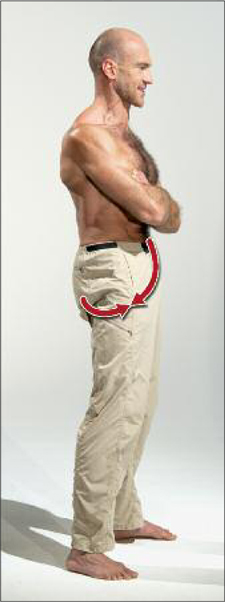
Knees locked. Pay attention to how the “karate navel maneuver” subtly changes one’s posture in the second photo.
Not only does the karate navel maneuver give the abs a better workout, it will make you noticeably stronger in exercises like military presses and pullups. And make your back considerably safer in the former. We use this procedure in many Hardstyle exercises. I must remind you: the effectiveness of the system lies in subtleties like this one.
It is interesting that either loose and weak or tight pelvic floor muscles lead to different health problems, including, surprisingly, orthopedic issues. Strength training must be balanced with stretching. In the case of the PF, deep squats will do the trick.

Dan John’s goblet squat is a great way to stretch the pelvic floor.
If your hip flexors, the muscles on the top of your thighs that raise your knees, are too tight, you will not be able to perform the karate navel maneuver. Stretch them with the following move and then revisit this powerful karate technique. How do you know if your hip flexors are too tight?—By your posture. Stand up ramrod straight and have someone watch you from the side. If your lower back is very arched and your butt is sticking out, you have this problem. Ditto if you are unable to lock out your knees while standing straight.
I have described several effective hip flexor stretches in my books and DVDs. Here is one more variation recently developed at the RKC school of strength. Assume the kneeling lunge position with your knee very well padded by something like a folded pillow. Do it even if you are a tough guy; knee discomfort will distract you and prevent you from relaxing.


RKC hip flexor stretch 2.0.
Your hips must be square and your torso upright at all times. Your feet and knees should be positioned as they would be if you were to half-kneel wearing cross-country skis and touched a ski with your knee. In other words, nothing should be flopping or twisting away from the planes formed by the “skis”. Imagining that you are squeezing something between your knees will help you maintain this alignment.
We are going to start by stretching your right hip flexors, hence your left foot will be in the front. The shin of the front leg should be near vertical; you may have to step forward during the stretch as you are sinking lower and the knee is moving forward.


You may hold on to something with your left hand for balance. This object must be on your left and not in the front.
Place your straight arm on the inside of your left knee and push back in order to make your upper back ramrod straight. Raise your chest and head high; Master RKC Dan John would cue you to “be proud of who you are”. Your right elbow must stay locked for the duration of the stretch to prevent you from leaning forward and reducing the stretch.
Posteriorly tilt your pelvis: turn your belly button up towards the sky. Maintain this orientation, or at least intention, for the duration of the stretch.


RKC hip flexor stretch 2.0.
Squeeze both glutes and push your pelvis forward. Your pelvis, not your chest! The hips must lead and most of your weight must stay on the rear knee.
You will feel a stretch on the top of the right thigh. Now all you have to do is relax and let your pelvis sink. This requires patience—you need to allow the stretch to happen, not make it happen.

Breathe deeply and slowly. Passively let out all your air with sighs of relief—the opposite of Hardstyle breathing. It helps to visualize breathing out through your tight hip flexors, “breathing the tension out”.
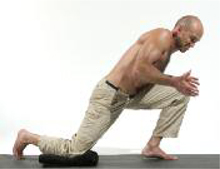
Stay down for as long as you can handle it. Stretch each side two to three times almost daily. You may do all your sets back to back, with a couple of minutes of rest, or spread them throughout the day.
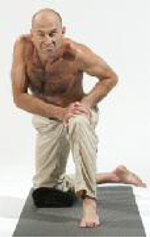
The many ways to make your hip flexor stretch ineffective.

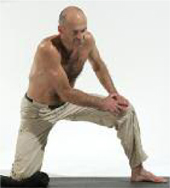
Back to our abdominal training with Hardstyle breathing. Here is a variation to give your obliques something extra to worry about. Instead of crunching forward slide your left elbow down lower and lower towards your pelvis, as if a devastating roundhouse kick is coming to your ribs on that side. Maximally shorten the distance between the ribs and the left front corner of the pelvis but don’t twist your spine. Do one rep to the left, one to the right, and one to the front.
A word about progression. You can add sets—up to a point. Adding reps is a decidedly bad idea. The amount of tension will be reduced as you fatigue. And subconsciously you will be teaching your body a lesson: “Don’t tense so hard, there are many reps ahead, better pace yourself!”
You can make Hardstyle breathing as hard as you want by pressing your tongue harder against your teeth and making a smaller opening. Bernoulli’s law decrees that if you reduce the diameter of the opening in half, the resistance to the gas’ flow will increase fourfold.
Practice Hardstyle breathing almost every day, throughout the day, for instance a set every hour. One can easily recover from this type of exercise, so it will not take anything away from your sports and strength training. Make each rep as concentrated as possible and don’t forget to take long breaks between sets in order not to get lightheaded. Keep the pressure in your stomach and away from your neck, face, and head. Stretch your abs after every set.
Do not do any other direct abdominal training—I insist. You may continue your strength training as usual.
Eat as a Russian noble or an officer in Imperial Russia’s officers’ corps. As described by Leo Tolstoy in Anna Karenina in the late XIX century:
Vronsky came to the regimental mess for his beefsteak earlier than usual. There was no need for him to follow strict training, since his weight came in just under the regulation hundred-sixty pounds; but he had to avoid getting fat too, and he avoided sweet and starchy food.
In the end of two weeks you should see a very noticeable difference in your “dear abbies”. Before moving on to the next phase please drop me a note on the www.DragonDoor.com forum and let me know how well you are doing.